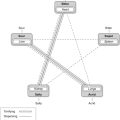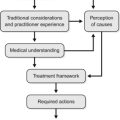3 Principles of herbal treatment
Chapter contents
First principles of traditional herbal treatment
As any review of herbal traditions from around the world will confirm, the use of plants in medicine reflects the enormous diversity of local traditions, with much more variety than consistency. However, more consistent themes emerge in history, most clearly where local folk practices were systematised in the great written traditions, reviewed in Chapter 1.
Cleansing: detoxification and elimination
The task of the physician was equally clear: to support eliminatory functions as vigorously as possible compatible with the body’s vital reserves (eliminatory functions were mostly seen as taxing the body’s energies). In practice this meant robust ‘heroic’ treatments in acute disease, notably involving emetics, purgatives, powerful expectorants and, in fever management, diaphoretics. In chronic and debilitated conditions the aim was to use gentler treatments, peeling away toxic accumulations like the layers of an onion, always making sure that eliminatory measures, laxatives, diuretics, choleretics, expectorants and the more systemic lymphatics and alteratives were supported by adequate sustenance for the vital functions: rest, nourishment and the use of tonic remedies (see below).
Cooling: stimulating digestion
The archetypal digestive stimulants were the bitters. Of all the herbal strategies in history, these are probably the most respected (the Chinese even gave them the awesome role in their five-phase classification of tonifying the Kidneys – the source of constitutional energies in their system). Bitters are universally used before and after eating as appetite stimulants (‘aperitifs’) and digestives. They were the first resort in digestive difficulties, especially when associated with heat and hepatobiliary (‘damp-heat’) disorders (bitters are also the most commonly used choleretics). Critically, they were also favourite febrifuges, apparently lowering body temperature in fever. They appeared to correct an apparent design inconsistency in the febrile response, wherein digestion is shut down, leaving undigested material as a source of new toxicity and even the original source of infection in the case of gastroenteritis. Bitters appeared to switch on digestive defences as well as bring the fever down. In many cultural traditions bitters were seen as primarily cooling (although in northern European traditions especially, some bitter remedies were classified as ‘heating’ for their stimulant properties – and possibly as a reflection of the prevailing cold environment). Unlike other cooling agents that counteracted vital functions, bitters appeared to transcend these limitations, to convert heat and vitality into nourishment. This was sometimes regarded as magical.
Approaches to using herbs
Instant treatments: trigger-point phytotherapy
Herbal medicine has developed the reputation in modern times of being an innocuous alternative to conventional drug treatment. It is often thought that if the remedies work at all, it can only be after weeks or months. The French term médecine douce sums up a modern European view of herbal medicine; that it is ‘soft’ and above all safe, free from the side effects of modern chemical drugs.
One of the tactics adopted was the use of remedies for provocation. The heroic techniques of emesis and catharsis were merely the most dramatic of the approaches used: the bitter digestives and cholagogues, circulatory stimulants, topical rubefacients and expectorants are more gentle examples of remedies that nudge the body towards hopefully useful activity. All these effects are short term, even immediate, as are the measures adopted for symptom relief: the demulcents, carminatives and spasmolytics. These categories of activity link closely to categories of plant constituents (see Chapter 2) and recur again and again in human history. They now may make a persuasive case for modern herbal therapeutics.
Other healing strategies
Convalescence
Rest
This is by far the most important element. It should include maximum sleep, as physiologically this is the body’s time for repair. In the early stages of vigorous convalescence almost constant sleep should be encouraged (as in the former ‘sleep clinics’). Thereafter it should be promoted as much as possible. Rest also means less activity: if work has to be done it should be in brief bouts, switching frequently between different activities (‘change is as good as a rest’). Patients should be encouraged to pace themselves, to go to bed early, sleep late and not to volunteer for any work that is not absolutely necessary. As much as anything rest becomes a mental priority: all other considerations are secondary. That hour of more sleep is more important than a film on TV, a late-night conversation or night out.
Nutrition: helping to convert foods into nourishment
The phytotherapist would want to answer such questions satisfactorily before embarking on extra dietary measures. Referral to the sections on treating digestive, bowel and liver problems and the section on acupharmacology (p. 187) should provide a rich range of tactics to modify digestive performance and modulate dietary measures. Appropriate use of eliminative or heating remedies may provide additional influence on dietary metabolism. Phytotherapy provides unique opportunities to convert food into useful nourishment. It gives dietary therapy much added value.
Bibliography
Brock AR, (trans.), Galen: On the Natural Faculties, London, Heinemann, 1952.
Cook WH. The Science and Practice of Medicine. Cincinnati; 1893.
Dash BV. Fundamentals of Ayurvedic Medicine. New Delhi: Konark Publishers; 1987.
Singer PN (trans.). Galen: Selected Works. UK: Oxford University Press; 1997.
Lyle TJ. Physio-Medical Therapeutics, Materia Medica and Pharmacy. Ohio; 1897.
Nutton V. Ancient Medicine. Routledge, 2005.
Porkert M. The Essentials of Chinese Diagnosis. Zurich: Acta Medicinae Sinensis, 1983. pp. 39–44
Porkert M. The Theoretical Foundations of Chinese Medicine. Massachusetts: MIT Press, 1978.
Pormann PE, Savage-Smith E. Medieval Islamic Medicine. Edinburgh: Edinburgh University Press, 2007.
Thomson S. New Guide to Health; or the Botanic Family Physician. Boston; 1835.






